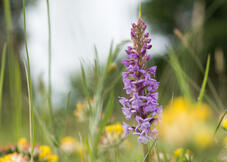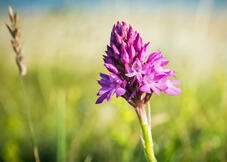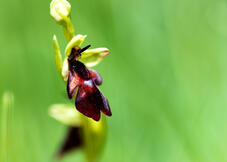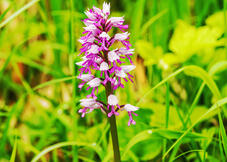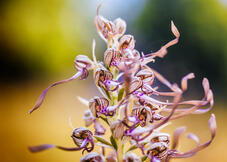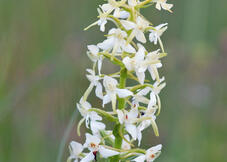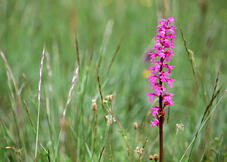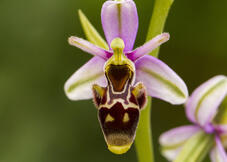Terrestrial Orchids: The most beautiful native species
Why go too far? We also have some Orchids that are in no way inferior to the exotic counterparts from the tropics. Introducing the most beautiful Terrestrial Orchids.
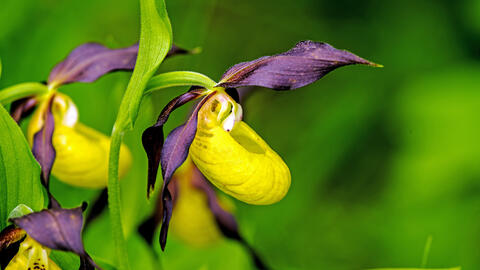
Lady's Slipper Orchids, here Cyprpedium Calceolus, are among the best-known native Orchids
When it comes to Orchids, most people think of the exotic indoor plants that adorn many a windowsill with their striking flowers. The plant family is spread worldwide. One finds the majority of the approximately 18,000 types in tropical areas where they live predominantly as epiphytes on trees. In contrast to their tropical relatives, they all grow on the ground (terrestrial) and are therefore also called Terrestrial Orchids. In the following paragraphs, you will find interesting information about the most beautiful native species.
The beauty of many native Orchids often only becomes apparent at second glance — not all of their flowers are as impressive as their best-known representative: The Lady’s Slipper (Cypripedium). Many species grow to a height of just 5.9 inches and therefore have small flowers. But if you take a closer look at them, you will notice the kinship.
Although the number of native Terrestrial Orchids has declined sharply, the plants have developed impressive strategies to ensure their survival. There is hardly any other plant family like this. For example, some species attract their pollinators by imitating female insects (for example, the various Ragwort species). Other native types like the Lady's Slipper simulate not existing pollen or nectar, as well as hold the insects so long in its blossom trapped, until these have given away pollen as well as have taken away.
Another characteristic of the Terrestrial Orchids is their behavior in the germination stage: Since the seeds have no nutritive tissue, they rely on certain fungi for nutrition. As soon as the first leaves sprout, the plant takes care of itself by photosynthesis. One exception is the variety is the Bird’s-nest Orchid that has no green leaves that are required for photosynthesis. They are dependent on fungi throughout their lives. Native orchids such as Bee Orchid (Ophrys Apifera) sometimes grow in gardens, parks or right at our doorstep. Their tiny seeds are often carried through the air for miles and often find ideal starting conditions on lawn areas that are not well cared for. If you do not mow too early, the Orchids might even bloom here.
For the most part, the Terrestrial Orchids thrive in extensively used areas. Surfaces that are subject to minor human intervention. These can be broadly classified into three different habitats: Calcareous grassland, forest and wet meadows.
Calcareous grasslands are nutrient-poor, often dry meadows and pastures. The soil is shallow, the plant cover is quite sparse. But what sounds like adverse conditions is of high ecological value: In contrast to intensively used grasslands, neglected grasslands are home to a large variety of rare animals and plants. BeeOorchid species (Ophrys) feel just as comfortable here as the Lizard Orchid (Himantoglossum hircinum) or Pyramidal Orchid (Anacamptis pyramidalis).

In semi-natural forests Terrestrial Orchids grow with less light, for example Narrow-Leaved Helleborine (Cephalanthera) or some Epipactis species. It is not uncommon for the flowering beauties to be right beside you on the wayside.
Another essential habitat for Terrestrial Orchids are wet meadows and moors. Found in valleys and lowlands where rainwater accumulates, or near rivers and streams that regularly flood. Apart from typical moisture indicators such as sedges and rushes the Terrestrial Orchids such as Marsh Helleborine (Epipactis palustris) and various wild Orchids (Dactylorhiza) grow here.
Terrestrial Orchids are under strict species protection because their existence in the wild is at great risk. The natural habitats of Terrestrial Orchids are shrinking day by day. Majority of the land is used for agricultural purposes - or used as construction land. The increasing drainage of soils with simultaneous eutrophication, i.e., excessive accumulation of nutrients such as phosphorus or nitrogen compounds in the water (over-fertilization), also contributes to this. The native Orchids are also not very assertive and are quickly replaced by other, more competitive species.

If, for example you wish to have a swamp garden with native Terrestrial Orchids you should only buy the plants from dealers who have a CITES certificate ("The Convention on International Trade in Endangered Species of Wild Fauna and Flora")". This certificate provides information about the country of origin and whether the plant actually comes from artificial reproduction. Especially with the strictly protected plants, the ones given in Appendix 1, which also include the Lady's Slipper, (Cypripedium) you should always show a proof of origin and an import permit.
Nevertheless, some Terrestrial Orchids can also be kept in your own garden. They look stunning in natural gardens and flower beds, preferably in a humid and shaded location. However, it is important that they are not subjected to waterlogging and that the soil is well drained.
In the meantime, researchers have succeeded in reproducing the Lady's Slipper Orchid from seeds in vitro, so that more specialist nurseries can offer them. The Lady's Slipper Orchids (Cypripedium hybrids) are also winter hardy and tolerate temperatures of lower than -4 degrees Fahrenheit - provided they are under a protective blanket of snow. Otherwise you would have to cover it with a layer of pine twigs or something similar. The best time to plant the native Orchid is in fall, when the plant is in its dormancy period. In early summer it will delight you with numerous flowers — giving your garden a fresh new look.
The Green-winged Orchid (Orchis Morio) is also very easy to maintain. If the soil in your garden is not too acidic or fertilized too much, the delicate violet-red, pink or white flowers of the earth Orchid appear from April to May. It grows up to 3.93 to 7.87 inches high and is perennial. Ideally they should be planted in clusters Stone garden or a flower bed. The plant reproduces itself through sowing.
The native Bee Orchid species (Ophrys) are found in areas that are warm in summer and therefore they need a protected place in the garden. We recommend placing them in a well-drained soil that is poor in humus, which also allows rainwater to drain away quickly. However, the Orchids cannot tolerate complete drought and start shrinking prematurely. You need to water it regularly.









